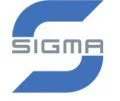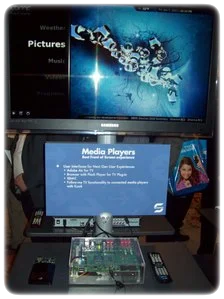Updated: More About Sigma
Cory

Update: There was a typo in Sigma’s press release and our resulting post. Their XBMC port was done on the SMP 8656 which supports Open GL ES. GLES will also be supported on Sigma’s recently announced SMP 8910, so this may be a potential target for XBMC as well.
For those asking “Will a potential XBMC port be possible for my xyz Sigma-based device?”, it is only a possibility if GLES 2.0 is supported.
–
For those who may have missed the previous post, Sigma Designs announced last week that they have begun work on porting XBMC to run on their next-generation SOCs, and showed off their nascent project at the 2011 CES. After meeting with a few Sigma employees, I wanted to give more detail into what is going on.
Sigma hired a 3rd party company to do their initial port, which is shown in the picture below. A proof-of-concept is up and running on their SMP8656, and while the GUI is choppy and playback is still not working, it is an impressive effort so far. There was a significant amount of interest in the port from CES attendees, who quickly appreciated XBMC’s rich experience compared to the user interfaces usually found on Sigma-based hardware.
Sigma has also expressed an interest in working directly with XBMC developers rather than using an outside company. This leads to the possibility of full-time XBMC devs, which would be a win for everyone involved. We are looking into our options. If the collaboration succeeds, it is quite possible that some turn-key XBMC solutions could be in the works in the not-so-distant future.
This is getting interesting!
- The collaboration has just begun, the above is subject to change.
- Don’t expect to see a Sigma-based XBMC solution on shelves in the next few months. These things take time.
- The capabilities will depend on the SOC used, nothing is set in stone yet.
- Sigma takes the GPL seriously, as do we. We do not foresee any problems.
- XBMC may be launched as an application, or run as the main front-end, depending on what the vendor wants.
